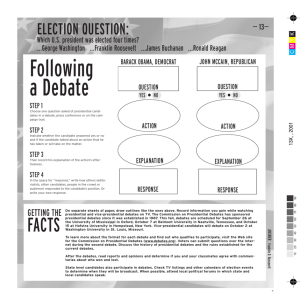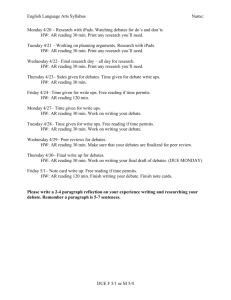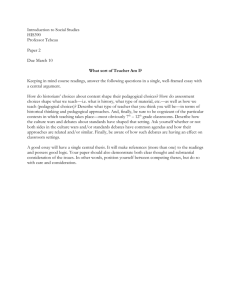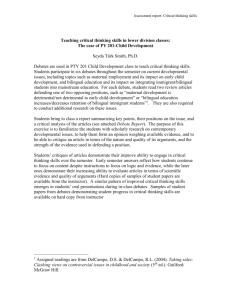GOREBUSHDEBATE - Get Well Kathleen Davey
advertisement
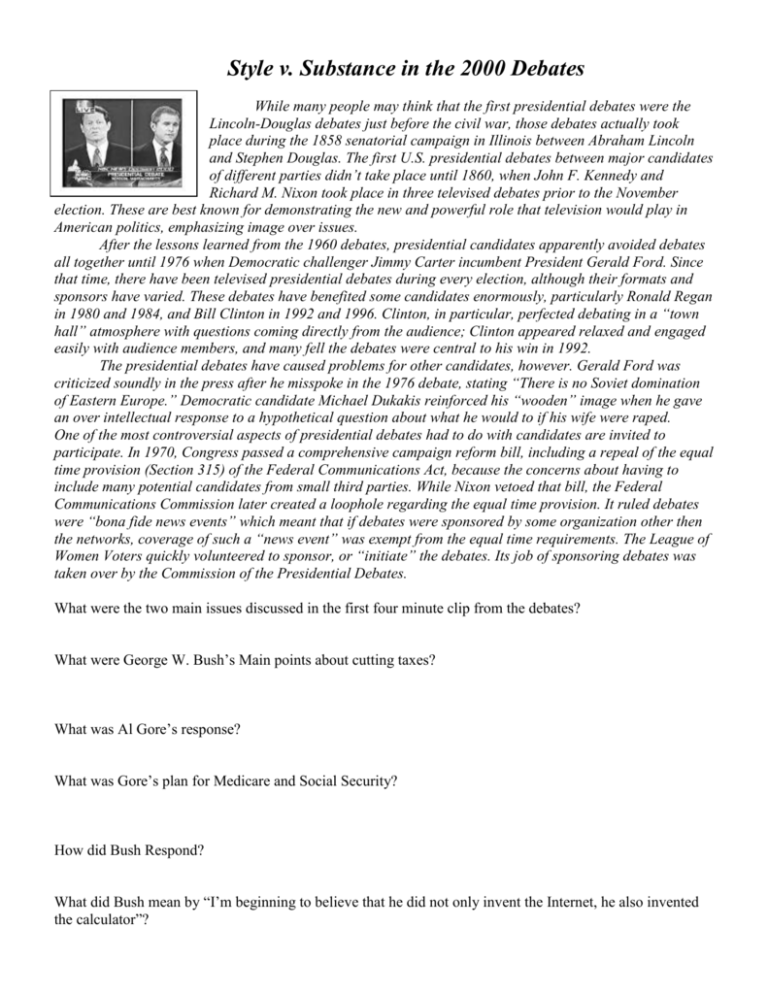
Style v. Substance in the 2000 Debates While many people may think that the first presidential debates were the Lincoln-Douglas debates just before the civil war, those debates actually took place during the 1858 senatorial campaign in Illinois between Abraham Lincoln and Stephen Douglas. The first U.S. presidential debates between major candidates of different parties didn’t take place until 1860, when John F. Kennedy and Richard M. Nixon took place in three televised debates prior to the November election. These are best known for demonstrating the new and powerful role that television would play in American politics, emphasizing image over issues. After the lessons learned from the 1960 debates, presidential candidates apparently avoided debates all together until 1976 when Democratic challenger Jimmy Carter incumbent President Gerald Ford. Since that time, there have been televised presidential debates during every election, although their formats and sponsors have varied. These debates have benefited some candidates enormously, particularly Ronald Regan in 1980 and 1984, and Bill Clinton in 1992 and 1996. Clinton, in particular, perfected debating in a “town hall” atmosphere with questions coming directly from the audience; Clinton appeared relaxed and engaged easily with audience members, and many fell the debates were central to his win in 1992. The presidential debates have caused problems for other candidates, however. Gerald Ford was criticized soundly in the press after he misspoke in the 1976 debate, stating “There is no Soviet domination of Eastern Europe.” Democratic candidate Michael Dukakis reinforced his “wooden” image when he gave an over intellectual response to a hypothetical question about what he would to if his wife were raped. One of the most controversial aspects of presidential debates had to do with candidates are invited to participate. In 1970, Congress passed a comprehensive campaign reform bill, including a repeal of the equal time provision (Section 315) of the Federal Communications Act, because the concerns about having to include many potential candidates from small third parties. While Nixon vetoed that bill, the Federal Communications Commission later created a loophole regarding the equal time provision. It ruled debates were “bona fide news events” which meant that if debates were sponsored by some organization other then the networks, coverage of such a “news event” was exempt from the equal time requirements. The League of Women Voters quickly volunteered to sponsor, or “initiate” the debates. Its job of sponsoring debates was taken over by the Commission of the Presidential Debates. What were the two main issues discussed in the first four minute clip from the debates? What were George W. Bush’s Main points about cutting taxes? What was Al Gore’s response? What was Gore’s plan for Medicare and Social Security? How did Bush Respond? What did Bush mean by “I’m beginning to believe that he did not only invent the Internet, he also invented the calculator”? Why did Gore tell the story about George McKinney from Milwaukee who was in the audience? Why did Bush say, “I’m not from Washington, I’m from Texas”? Why do you think Ralph Nader was not in the debates? Explain: An image can be more decisive than reality in influencing votes in the presidential elections. Gerald Ford was one of the more athletic of modern Presidents. He played all-state football in high school, and was an all-star on the two-time national championship University of Michigan football team. Yet Ford has suffered an enduring image of klutz, partly due to several trips and stumbles by TV cameras and appeared on the nightly news. This image was reinforced by when Chevy Chase began appearing as Ford in humorous skits on the popular TV comedy show Saturday Night Live. Chase made a regular gag out of pretending to trip and hurt his head, and thanks to the power of comedy TV to leave lasting impressions, President Ford continues to be remembered as our most uncoordinated President. In 2004 a Pew Research Center Poll found that 18-to-29 year olds said they regularly for information about presidential candidates and campaigns from comedy TV shows. Although these programs are not produced to serve as credible sources of information, their comment may ultimately influence our nation’s choice of President, particularly for young voters. The next video you will see is an excerpt from a Saturday Night Live skin that aired just four days after the presidential debate between Bush and Gore that you just saw. As you watch this clip, think about what messages are being communicated about each of the candidates. What impressions did the skit give of Al Gore? What things in the skit gave you that impression? What impressions did the skit give of George W. Bush? What things in the skit gave you this impression? After the airing of the SNL debate skit, Al Gore’s advisors made him watch the episode. Accordingly his demeanor changed sharply in the second debate which allowed him to be portrayed by the Republicans as a flip-flopper and ask a question that resonated with some voters…”who is the real Al Gore.” What do you think they told him based on the way SNL portrayed him during the second debate? Which is more important in a debate..style or substance?


